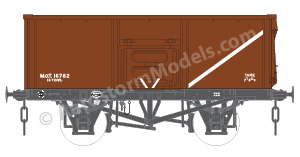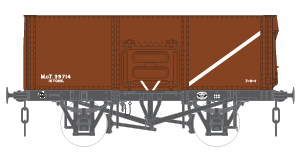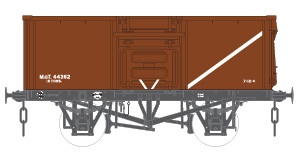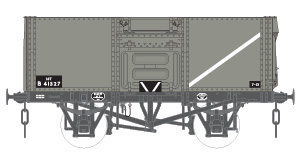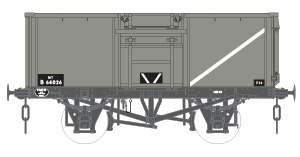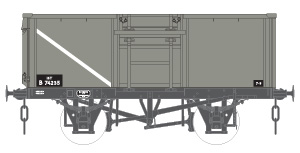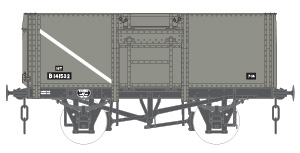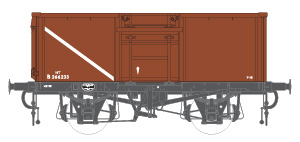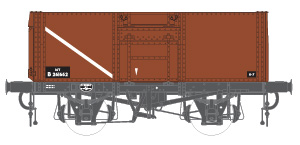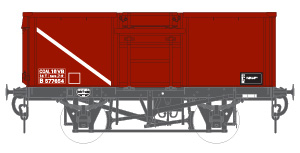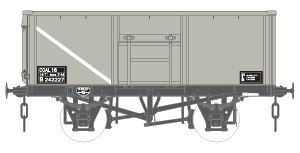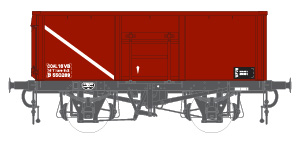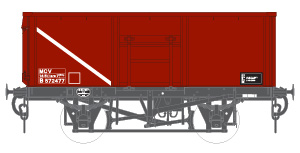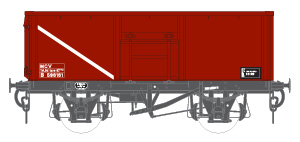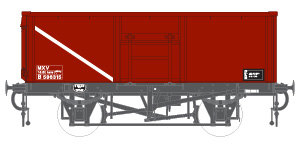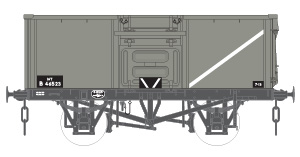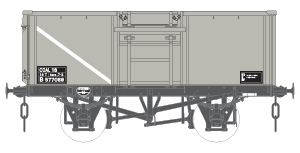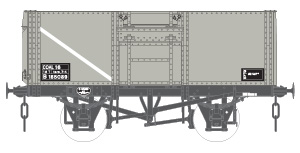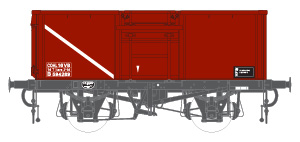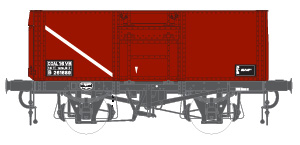Steel Mineral Railway Wagons
Scale Drawings for Models
This page introduces the range of scale drawings I have available for you to produce models of all-metal (usually steel or wrought-iron) railway wagons that were used to carry minerals such as coal for the commercial customers of the railway companies. Similar wagons that the railway companies used to carry coal for their own use (e.g. loco coal) will be covered by a separate page. This page covers those wagons with the traditional rectangular body shape, similar wagons with wooden bodies, and hopper wagons, will also be covered by separate pages.
The illustrations below are a selection from these drawings, in a variety of liveries, reduced in size for on-screen viewing.
Note: Clicking on any of the images on this page, such as those above, will cause a larger version of the image to appear in a new tab or window of your browser (depending on how your browser is set up).
Most of these wagons were provided with a combination of side, end and bottom doors. Individual wagons may have omitted some of these door types. A few wagons were provided with no doors at all, to be emptied by bodily rotating the wagon about its long axis in a device known as a "rotary tippler". Such wagons were knowns as "tippler" wagons, and drawings of wagons similar to those povided with doors will be included in this section.
In the sections below I give a brief history of the development of these wagons, and each section is provided with links to pages where you can order drawings of the appropriate wagon types.
As with all of my standard drawings, each drawing is available in a range of scales, from 2mm:1ft (N gauge) to 16mm:1ft, and most common scales in between. Once you have bought a particular drawing, you will be able to download versions of it in any or all of the available scales. At extra cost I can also provide copies of drawings at a specific scale printed onto A3 or A4 paper and sent to you by post.
Index
Early Designs |
Drawings in preparation | |
GWR Designs |
Drawings in preparation | |
Pre-war Designs |
Drawings in preparation | |
Wartime Production |
Drawings in preparation | |
LMS & LNER Designs |
||
MoT Post-war Designs |
||
British Railways Standard Designs |
||
Later Conversions |
||
Larger Mineral Wagons |
Drawings in preparation | |
Tippler Wagons (coal & iron ore) |
Drawings in preparation | |
Tippler Wagons (sand) |
Drawings in preparation |
Clicking on the "Go To Intro" buttons will take you to the corresponding section of the Brief History below.
Clicking on the "Go To Drawings" buttons will take you to the corresponding page where you can select which drawings you wish to order.
A Brief History
Early Designs
From as early as 1903, the Railway Clearing House (RCH) produced standardised designs for all-metal mineral wagons, to be built by the various independent manufacturers for their customers. Some of those manufacturers also produced their own designs. However, metal wagons proved to be unpopular with the vast majority of private wagon owners, and very few wagons were built to these designs. The advantages of increased robustness and longevity presumably weren't sufficient to outweigh the additional cost up front.
I currently have no drawings for wagons of this period, but some are in preparation.
GWR Designs
Alone among the pre-grouping and grouping railway companies the Great Western Railway was an early adopter of metal construction for its wagons, both for metal underfames with a wooden body and for all-metal construction for certain types of wagon, particularly its loco coal wagons. This started as early as about 1894 with diagram N6. Diagram N7 reverted to wooden body on metal underframe, but after that all loco coal wagons were of all-metal construction, eventually reaching diagram N34 (although this sequence does include a few hopper wagon designs).
The vast majority of these wagons were for the GWR's own use, but in the 1920's and 30's, under the management of Sir Felix Pole, the GWR tried to popularise the use of metal mineral wagons by producing wagons to hire out to private operators, with some success. The GWR retained ownership of these wagons, and they were mostly finished in standard GWR livery, but with additional markings identifying the private operator. A few were turned out in full private owner liveries.
Most, if not all, of these wagons were actually built by independent manufacturers such as Charles Roberts and Gloucester RCW, rather than at Swindon. These manufacturers also produced wagons of similar design for sale to their customers as normal private owner wagons.
I currently have no drawings for wagons of this type, but some are in preparation.
Pre-war Designs
The "private" GWR wagon designs were all of the larger 20T capacity, rather than the 12T of typical wooden-bodied private owner wagons of the time. As well as producing wagons based on the GWR designs, some of the manufacturers involved also produced designs of their own for the smaller type of wagon, notably Charles Roberts and Butterley who both patanted their construction methods.
I currently have no drawings for wagons of this period, but some are in preparation.
Wartime Production
During World War II the then Ministry of War Transport took over the operation of much of Britain's railway network, especially freight operation. Most common types of wagon were "pooled" together and operated under the instructions of the MWT. This included most of the mineral wagons previously operated by both railway and private owners. In principle, any wagon deemed suitable for a load could be sent anywhere in the country, potentially far from it's owner's territory. The relevant owners, railway or private, received a standard fee each time one of their wagons was used.
During this period, with the general shortages of materials and skilled labour, the production of new wagons was restricted, and had to be authorised by the MWT. As the war went on, the need for new wagons increased, and the MWT controlled and authorised their production. For mineral wagons the MWT standardised on all-metal construction. The pre-war Charles Roberts design dominated this production along with a more conventional design by Hurst Nelson. Although nominally still owned by private owners, the new wagons went straight into the pool. They were generally finished in a standardised, simple livery that included the owner's details in smaller lettering than previousl common for private owner wagons. A few were, however turned out in full PO livery.
I currently have no drawings for wagons of this period, but some are in preparation.
LMS and LNER Designs
In 1945-6 the MWT (or MoT as it became) authorised the production of mineral wagons to new designs for the LMS and LNER. The LNER wagons, to diagram d188, were of riveted body construction with welded underframes, and were mostly built by independent manufacturers. The LMS wagons, to diagram D2109 had welded bodies with riveted underframes. Further production to diagram D2134 was ordered by the LMS but not delivered until after nationalisation in 1949.
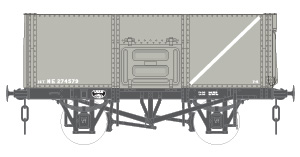
LNER Diagram 188 wagon, |

LMS Diagram 2109 wagon, |
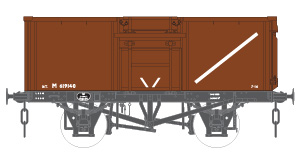
LMS Diagram 2134 wagon, |
For the drawings I have for wagons of this period, such as the selection illustrated above.
MoT Post-war Designs
For the first few years after the war the Ministry of Transport remained in control of railway operations, including the production of new wagons. During this period the MoT ordered many steel mineral wagons. Initially these continued with the wartime Charles Roberts and Hurst Nelson designs, followed by new standard designs that were very similar to the LMS diagram D2109, with either welded or riveted bodies. These were finished in a standard MoT bauxite livery, the colour reputedly being the same as the then current LMS shade of bauxite.
Coal traders in the London area had an agreement with the trade unions that limited the height of wagon sides that their workers had to unload. The new MoT wagons exceeded this height limit, so extra top flap doors above the side doors were added to the designs for further new production, including the LMS wagons to diagram D2143. Existing wagons were not modified.
Once the railways were nationalised in 1948, British Railways took over control of the railways, and ownership of the pooled wagon fleet, from the MoT. Many of the post-war wagons ordered by the MoT weren't actually delivered until after nationalisation, although often still finished in MoT livery.
The Charles Roberts and Hurst Nelson designs were given British Railways diagrams 1/100 and 1/101, respectively. The D2109-like designs were given diagrams 1/102 and 1/103, for the welded and riveted version respectively. The later versions with top flap doors were likewise given diagrams 1/104 and 1/105. The Charles Roberts wagons returned from France were given the standard 1/100 diagram number, but the Hurst Nelson wagons were given diagram 1/113. The wagons of French design were given diagram 1/112.
For the drawings I have for wagons of this period, such as the selection illustrated above.
British Railways Standard Designs
From around 1950 it was decided that bottom doors for mineral wagons were no longer required, and new designs were issued without them, to diagrams 1/108 and 1/109 for welded and riveted bodies respectively. The absence of bottom doors meant that the braking arrangements could also be simplified, with brake shoes on one side only, operated by both brake levers (usually by means of a Morton clutch). Previously, the earlier wagon designs had brake shoes on both sides of the wagon but the levers only operated the brakes on the same side of the wagon, there being no connecting bar under the wagon that would foul the bottom doors. Many earlier wagons later had their bottom doors sealed shut, althouhgh their brakes remained the same.
These diagrams became the basis for all subsequent BR production of smaller mineral wagons, with some variations and evolution, as diagrams 1/111, 1/114, 1/116 and 1/117. From mid-1955 the later batches of wagons to diagram 1/108, and those to the almost identical diagram 1/117, were delivered with a mix of braking systems: some were fitted with 8-shoe clasp vacuum brakes; some were prepared for later vb fitting with 8-shoe clasp brakes, longer buffers and screw couplings, but no hoses or cylinders; others were not vacuum fitted all, with standard 2-shoe Morton brakes. A few diagram 1/109 wagons were also completed with 8-shoe vacuum brakes. Problems with the unloading arrangements at Goole and the early vacuum brake systems meant that those wagons prepared for vacuum fitting were not so fitted later.
Diagrams 1/108 and 1/109 were the standard designs. It is not clear how diagrams 1/111 and 1/114 differed from the standard, and I do not have any information to be able to produce drawings of them. If anyone has authoritative information for this, please let me know and I'll gladly produce drawings to complete the series. Both of these diagrams were first produced by BR Derby, with the first 1/111 wagons following on from the first 1/106 wagons, so they could have been developments of the 1/106 design in the same way as 1/108 and 1/109 were developments of 1/104 and 1/105. Perhaps they acted as protypes for the 1/108 or 1/109 standard designs, as they were first produced about the same time as the first 1/108 and 1/109 were produced by independent manufacturers.
Diagram 1/116 was an experimental version of 1/109 using aluminium sheeting for the body rather the the usual steel. I've assumed they were visually identical to the standard 1/109 design, so I've included them with the 1/109 drawings rather than produce separate drawings.
Likewise it is also not clear how diagram 1/117 differed from 1/108. The information I have suggests that they were visually identical to the 1/108 standard, including with partially and fully fitted versions, so I've again included them with the relevant 1/108 drawings.
For the drawings I have for wagons of this period, such as the selection illustrated above.
Later Conversions
From 1966 onwards, many unfitted diagram 1/108 wagons were converted to vacuum brakes with a 4-shoe Morton system with 2 vacuum cylinders.
Between 1969-76 many unfitted diagram 1/108 wagons were fitted with new welded bodies, as the original diagram 1/108 but without the top flap doors. Between 1974-79 many fitted 1/108 wagons were similarly rebodied, along with a few fitted 1/109 wagons. This conversion programme included the earlier 1966 vb converted wagons.
In 1975-8 many Palbrick wagons were converted to minerals by fitting new bodies (to the same design as the other rebodied minerals) to their 10ft wheelbase underframes (the standard mineral wagons had a 9ft wheelbase). The resulting wagons had a mix of braking systems, buffers and axleboxes inherited from their donor wagons.
The "standard" 1/108 and 1/109 diagrams thus covered a number of significant variations. I have therefore devised a system of suffixes to distinguish the major variations:
- No suffix – The original 1/108 and 1/109 designs.
- VB8 – The original 1/108 and 1/109 designs fitted with the 8-shoe lift-link vacuum brake system from new.
- VB4 – The 1/108 wagons later fitted with the 4-shoe Morton vacuum brake system.
- R, RVB4, RVB8 – The rebodied versions of the 1/108 and 1/109 designs.
- PVB8a, PVB8b, PVB4 – The Palbrick conversions with LMS 8-shoe, lift-link 8-shoe, and 4-shoe Morton vacuum brake systems, respectively.
For the drawings I have for wagons of this period, such as the selection illustrated above.
Larger Mineral Wagons
At nationalisation the GWR and LNER both had outstanding orders for larger 20T loco coal wagons. The GWR wagons were to diagram N34 (all steel), the LNER to diagrams d77 (wooden bodies) and d207 (all steel). These wagons were completed after nationalsation and although originally intended to carry loco coal quickly passed into general use, and hence are included here.
In 1950 new designs were prepared for 21T coal wagons. These were essentially enlarged versions of diagrams 1/102-3 with two sets of side doors, one end door, and no bottom doors. Diagram 1/107 was for those with a welded body, and 1/110 for those of riveted construction.
In 1952 a new, larger design was issued, as diagram 1/115. This was essentially the same as 1/107 but significantly taller, rated at 24.5T, and was fitted with large top flap doors. Production continued until 1956, then in 1959 a revised version, to diagram 1/118 was issued, with self-contained or hydraulic buffers and roller bearings.
In 1962 production reverted to the smaller 21T size, as 1/107 but with top flap doors, hydrualic buffers, roller bearings and vacuum brakes. Diagram 1/119 had a manual control to disable vacuum operation, that allowed wagons to be used in unfitted trains. For diagram 1/120 this control became automatic, a system known as self-adjusting brakes, or SAB.
In 1975-6 many diagram 1/107 and 1/110 wagons were rebuilt with new bodies (of the same type as 1/107). Some 24.5T hopper wagons were also rebuilt in this way. From 1977 the rebuilding programme continued, now including diagram 1/115 and 1/118 wagons and the new bodies had only one side door and no end door. If the existing springs were reused, the resulting wagons were rated at 21T (or 21.5 tonnes). If new springs were fitted the rating increased to 25 tonnes.
I currently have no drawings for wagons of this type, but some are in preparation.
Tippler Wagons (for coal and iron ore)
In 1939-40 Charles Roberts built a large batch of their standard 14T mineral wagons (the design that became diagram 1/100) without any doors for their customer Stewarts & Lloyds. These were used as coal tippler wagons and survived until well into the 1970s, including after Stewarts & Lloyds becoming part of British Steel. At the same period a large batch of larger 20T iron ore tippler wagons was built for the same customer by a mix of several builders. These had hopper-like bodies with substantial vertical stanchions, and were similarly long-lived.
In 1949 the last of the batch of wagons to LMS D2143 were completed with stronger springs and axleboxes for use as 27T iron ore tipplers, to LMS diagram D2153. These wagons had the full complement of doors of the standard D2134 design.
In 1951 a new design of 27T iron ore tipplers was introduced, similar to D2153 but without any doors and an 8ft. 10in. body height. Diagram 1/180 was given to those built by independent manufacturers, and diagram 1/181 to those built at BR Derby and Shildon.
In 1953 diagram 1/183 was issued for new wagons with a body height of 8ft. 6in. but otherwise the same as diagrams 1/180-1.
In 1958 diagram 1/184 was issued for wagons with a wheelbase of 10ft., but otherwise as 1/183. These wagons had a mix of brakes, buffers and axleboxes, but none were vacuum fitted.
Finally, in 1960, diagram 1/185 covered wagons otherwise as 1/184, but with 8-shoe vacuum brakes, Oleo buffers and roller bearings.
I currently have no drawings for wagons of this type, but some are in preparation.
Tippler Wagons for Sand
In 1950 diagram 1/071 was issued for wagons to carry sand that were very similar to the contemporary 1/102 minerals, but with a reduced body height of 2ft. 6in. and no doors at all. With a load capacity of 13T they were built by BR Ashford and had Morton 2-shoe brakes. These were followed in 1951-2 by diagram 1/072 for apparently identical wagons built at BR Swindon. Most of these wagons later received vacuum brakes.
In 1957-8 otherwise identical wagons were built to diagram 1/073 but with 10ft. wheelbase, 8-shoe vacuum brakes and Oleo buffers.
I currently have no drawings for wagons of this type, but some are in preparation.




